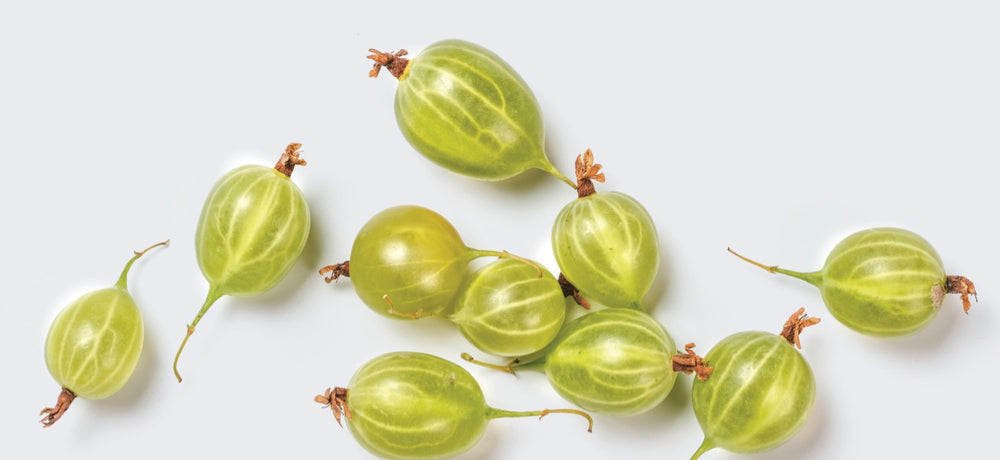
Amla: An ancient antioxidant.
By: Jeanne Ricks, CHC
When looking at a fruit like amla, or Indian Gooseberry, you first have to get past that quirky name. There's a reason that it's so widely used in the Ayurvedic medicine system of India - and that's because it provides some significant medicinal benefits. So much so in fact that it's difficult to know where to start. But, let us begin by really understanding why it is effective in improving your health in such a variety of ways. Then, we'll talk about some of those benefits.
First, let's get a name that commands a little more respect. Researchers know it not as Indian Gooseberry, but as amla (Emblica officinalis Gaertn.) Feels more important already, doesn't it?
The Breath of Life (oxygen)is a bit of a double-edged sword. Yes, you can't live without it, but it also speeds up your demise by playing a pivotal role in the aging process. How?
As if your 'regular' stress levels weren't enough to contend with, there's a condition that you unknowingly dance with quite often called 'Oxidative Stress.' Your body's not just dealing with bacteria and microbes that will damage your health. There are also harmful quantities of mold, fungus and yeast that it must balance out. To protect your body against oxidation, you create both oxidants (like hydrogen peroxide) and antioxidants. When that balance of oxidants and antioxidants is too heavily weighted with oxidants, you get oxidative stress.
You may recall from high school chemistry that electrons are the "glue" that hold atoms together in molecules. All kinds ofelectrontransfers occur between molecules when they are at work in the numerous chemical reactions that go on in your body all the time. Sometimes, during these reactions, electrons are transferred to oxygen.
You may have heard the termFree Radicals. That's the name for these chemically unstable molecules or atoms. They also make other molecules or atoms in your body volatile, which in turn damages proteins, cell membranes, and even your DNA.
When this happens, you now get a highly reactive "superoxide" ion that attacks and rips other molecules apart. This process leads to permanent cellular damage and damage to your tissues resulting in infection, mental decline, a depressed immune system, joint disease, heart disease, and plays an essential role in the aging process.
Fortunately, your amazing body has evolved a defense system - in this case, an enzyme called "superoxide dismutase (SOD)." Its function is to get rid of that superoxide by converting it into Hydrogen Peroxide, which, although potentially dangerous, is still less risky than superoxide.
Still, it does present a risk, and this is where catalase enters the picture. It breaks that hydrogen peroxide down into oxygen and water for easy removal from your body. This is why hydrogen peroxide is found in your breath when you exhale. Recent scientific studies show that low catalase levels are a factor in the graying process of your hair. You see,catalase enzyme productionnaturally declines as you age. When there is a drop in your catalase levels, hydrogen peroxide cannot be decomposed. This accumulation bleaches your hair from the inside out. In essence, the catalase deficiency allows a hydrogen peroxide build-up, bleaching your hair to gray then white.
This entire oxidative stress load is the culprit behind a wide range of illnesses: Type-2 Diabetes, atherosclerosis (or the hardening of the blood vessels), inflammatory conditions, high blood pressure, which is also known as hypertension, cardiovascular diseases, neurodegenerative diseases, such as Parkinson's and Alzheimer's, and even cancers.
Now we can talk about amla because research shows that it is highly effective in both the reduction and prevention of oxidative stress, which means it has a vast influence on a range of illnesses that challenge optimal health, including the aging process itself.
Various parts of amla are used to treat a range of diseases, but the most important is the fruit. It is not the tastiest treat; it's light green in color and can be quite tart and fibrous to eat. Growing naturally in the wet forests and hilly areas of the Indian subcontinent, you'll also find it in the Middle East and a few other Southeast Asian countries. It belongs to theEuphorbiaceae familyand naturally ripens in Autumn. While the tree is known as amla and considered sacred in India, it's also referred to as Amalaki in the holy texts of Sanskrit. Ayurvedic practitioners swear by the fruit to cure almost any health issue. In what are arguably the two most essential recipes in Ayurveda - Triphala powder, amla is 33% of the composition, and in Chyawanprash (with over 30 ingredients), it's 46% of the total by weight.
Preclinical studies have shown that amla has antipyretic, analgesic, antitussive, antiatherogenic, adaptogenic, cardioprotective, gastroprotective, antianemic, wound healing, antidiarrheal, antiatherosclerotic, hepatoprotective, nephroprotective, and neuroprotective properties. Amla is also reported to possess radiomodulatory, chemomodulatory, chemopreventive effects, free radical scavenging, antioxidant, anti-inflammatory, antidiabetic, antimutagenic and immunomodulatory activities, properties that are efficacious in the treatment and prevention of cancer.
Let's look more closely at the secret behind its powerful effects. Amla is made up of 80% water, in addition to protein, minerals, carbohydrates, and fiber; their beneficial properties are primarily due to thepotency of the antioxidantsthat it gives you. Amla is abundant in Vitamin C, Vitamin A, polyphenols, alkaloids, and flavonoids such as quercetin and kaempferol.
Compared to fresh oranges, you'll find that Amla berries have20-30x the concentration of Vitamin C. The raw powder is a rich source, too. A highly accurate way for you to find out the antioxidant activity in your fruits and vegetables, is by using theORAC scale. Here's how 100 grams of amla compares to other superfoods that you're familiar with:
- Fresh Blueberries = 4,669
- Spirulina Powder = 5,970
- Maca Powder = 6,100
- Fresh Wild Blueberries = 9,621
- Fresh Black Raspberries = 19,220
- Acai Powder = 102,700
- Amla Powder = 261,500
Amla rates 55x higher than blueberries and 1.5x higher than acai!
A critical study on the hepatoprotective (liver damage preventing) properties of amla published in the journal Food & Function,showed that the fruit is effective in preventing the toxic effects of both excessive medication and toxic metals. The presence of phytochemicals such as quercetin, gallic acid, corilagin, and ellagic acid in amla helps in free radical scavenging and, in turn, in detoxifying your body. This, combined with a high concentration of antioxidants protects and reverses your oxidative stress levels.
But what about anti-aging and in terms of preventing genetic damage, such as chromosome misalignment? More research here needs to be done before we call this the 'Fountain of Youth'. However,in a recent studyusing healthy humanepithelial cells, when compared with the control (untreated) cells, those treated with a solution containing Amla fruit were found to have "decreased frequencies of all mitotic aberration biomarkers" or other signs of DNA damage. And yet another human study was published recently where healthy volunteers were given either amla or a placebo for 45 days. Their DNA was analyzed both before and after. Intake of Amla by aged individuals showed that they had stable maintenance of their DNA strand break repair without any toxic effects. In other words, their DNA health remained constant, and new damage was prevented.
Amla also contains high levels of folic acid and minerals like calcium, potassium, phosphorus, iron, and magnesium. This combination boosts your immune system and increases your production of white blood cells.
Amla has also been shown to both support and re-energize your liver. Too much fructose (sugar) is linked with both fatty liver disease and cardiovascular disease, especially in older women. In one study, intended to replicate the age of post-menopause, over an 18-week treatment period, some mice were given regular food while others were given a high fructose diet. When the group on a high fructose diet was given amla supplements daily, beneficial changes in the protein expressions of their livers were observed.
And while we're talking about sugar, a study conducted in Pakistan further concluded that Amla fruit demonstrated excellent properties fortreating Type-2 Diabeteswhile improving liver function when consumed regularly. It's been shown to help in controlling levels of both blood sugar and lipids. In addition to the bountiful antioxidants in amla, it contains chromium, which has a therapeutic value for Type-2 Diabetics. It has been shown tostimulate the isolated groupof cells you have that secrete insulin, which reduces the blood sugar levels in diabetic patients. Whenever your blood sugar is reduced, glucose is used by your cells as functional energy. This means that your metabolism is stronger, and you have more power, without the dips and spikes in blood sugar that are so dangerous for people with diabetes.
A study published in the International Journal of Food Sciences and Nutrition tested the effect of amla on two groups - one with healthy volunteers and one group with Type-2 Diabetes. At the end of the study, the participants with diabetes had significantly improved levels of both blood sugar and blood cholesterol.
When it comes to cholesterol, a recent study comparing the effects of amla and a statin drug on patients with high cholesterol levels had some exciting results. They found that the fruit had a cholesterol-lowering impact similar to the drug. Stunningly, more benefits were observed in those patients who were given amla. The researchers further stated that including amla in the diet could help prevent coronary artery disease and atherosclerosis.
Amla is also low in calories (remember the berries are tart, which means low in sugar), with 100 grams of the fruit providing only 44 calories, according to the USDA National Nutrient Database.
Amla also works well for inflammation. It is an excellent anti-inflammatory for joints, especially. Researchers from Ferrara University have found that amla extracts can slow the activity of osteoclasts (cells that break down bone). The anti-inflammatory properties of amla help to reduce pain and swelling of the bones in arthritis patients. This potent herb is also used to reduce fevers, strengthen the heart, control blood sugar, treat urinary tract infections, and improve eyesight.
So, as you can now see, there's an excellent reason that amla has been such a popular ingredient in most Ayurvedic formulations. The benefits speak for themselves.
Finally, as with any dietary complement, if you're considering using amla, talk to your healthcare provider before making any changes in your supplement regimen.
DISCLAIMER: This information is not intended as a substitute for advice provided by a competent health care professional. You should not use this information in diagnosing or treating a health problem. No claim or opinion in this blog is intended to be, nor should be construed to be, medical advice. If you are now taking any drugs, prescribed or not, or have a medical condition, please consult a competent physician who is aware of herb/drug interactions before taking any herbal supplements. The information presented herein has not been evaluated by the FDA or the Department of Health and is not intended to diagnose, prevent, cure, mitigate or treat any disease or illness.

Why Trust Vibrant Health?
At Vibrant Health, we’ve been pioneers in science-backed nutrition for over 30 years, formulating transparently sourced superfood supplements that prioritize real results. Our blog is an extension of that commitment—a trusted resource for expert-driven wellness insights.
Every article is crafted with nutrition expertise, backed by the latest scientific research, and reviewed by our in-house Certified Health Coaches and Product Educators. We break down complex health topics into practical, actionable advice—helping you make informed choices about superfoods, supplementation, and holistic wellness.As a brand that has earned thousands of 5-star reviews and the trust of health professionals, we ensure that our content reflects the same quality, integrity, and transparency as our products.
Your wellness journey deserves accurate, credible, and empowering guidance. That’s why Vibrant Health’s blog is here—to help you live a healthier, more vibrant life, backed by real expertise


